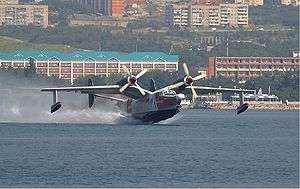Gull wing


The gull wing is an aircraft wing configuration with a prominent bend in the wing inner section towards the wing root. Its name is derived from the seabirds which it resembles. It has been incorporated in aircraft for many reasons.
Sailplanes
The gull wing was first seen on a glider when the Weltensegler flew in 1921. Its wings were externally braced and featured swept-back wingtips. After the aircraft broke up, killing its pilot, the design feature stayed out of popular use. The gull wing made a resurgence in 1930 with Alexander Lippisch's record-breaking Fafnir. Lippisch used the configuration for its increased wingtip clearance and the ill-founded belief it improved stability in turns. However, studies have shown that normal gull wing configurations have significantly less severe and more easily recoverable stalls. Inverted gull wings show the opposite stall behaviour, but both normal and inverted gull wings impede lift/drag ratio and climb performance.[1] The true success of the Fafnir's gull wing lay primarily in its aesthetic value; the gull wing would be a staple of the high-performance sailplanes of the time, until the 1950s.
Notable gull wing sailplanes:
- Bowlus Senior Albatross
- DFS Habicht
- DFS Kranich
- DFS Reiher
- Göppingen Gö 3 Minimoa
- Lawrence Tech IV "Yankee Doodle"
- Lippisch Fafnir
- Ross RS-1 Zanonia
- Schweyer Rhönsperber
- Slingsby Kite
- Weltensegler
Seaplanes

The gull wing design found its way into seaplanes by the early 1930s. As engine power increased, so did the need for large propellers that could effectively convert power to thrust. The gull wing allowed designers to ensure adequate propeller tip clearance over the water by placing the engines on the highest point of the wing. The alternative was placing the engine on a pylon. Possibly the first flying boat to utilize the gull wing configuration was the Short Knuckleduster, which flew in 1933. The Dornier Do 26, a high-speed airliner and transport platform, of which 6 aircraft were built, flew in 1938. The configuration was also used on the US Navy's PBM Mariner and P5M Marlin maritime patrol aircraft. The emergence of long range, land-based jets in the 1950s and the subsequent demise of the seaplane prevented widespread use of the gull wing, although it was still used in some post-war designs, like Beriev Be-12 Chaika (the name means 'the gull' in Russian).
Examples:
Landplanes
The gull wing design found its way into landplanes in the late 1920s, with Polish inventor Zygmunt Pulawski designing the PZL P.1 in 1928. The arrangement he devised is occasionally known as the "Pulawski Wing" or the "Polish wing". The gull wing was used to improve visibility in a high wing arrangement, because such wing could be thinnest by the fuselage, and in theory should limit pilot's view no more than A-pillars of a windscreen in a car body. It was used in fighter aircraft like PZL P.11 and Polikarpov I-15.
Examples:
Inverted gull wing



The inverted gull wing was also developed in the 1930s and was chiefly used on single engine military aircraft with increasing powerful engines. Before contra-rotating propellers came into use, such powers required larger diameter propellers but clearance between the propeller tip and ground had to be maintained. Long landing gear legs are heavy, bulky, and weaker than their shorter counterparts. The Vought F4U Corsair, designed from the onset as a carrier-based fighter, not only had the largest propeller of any U.S. fighter, but was also expected to face rough landings aboard a pitching carrier deck. The inverted gull wing allowed the landing gear to be short and strong, and to retract straight back, improving internal wing space. An additional aerodynamic advantage was that the wing/fuselage connection is perpendicular and has inherently lower drag than any other connection.
Another reason for having an inverted gull wing is to permit clearance for a large external bomb load, as on the Junkers Ju-87 Stuka.
Examples:
- Aichi B7A
- Blohm & Voss Ha 137
- Junkers Ju-87 Stuka
- Vought F4U Corsair
- Mitsubishi A5M
- Yermolayev Yer-2
References
- ↑ Abdulrahim, Mujahid; Lind, Rick. "Flight Testing and Response Characteristics of a Variable Gull-Wing Morphing Aircraft" (PDF). University of Florida. pp. 5–8. Retrieved 2012-04-28.